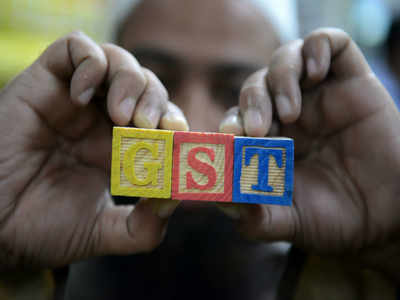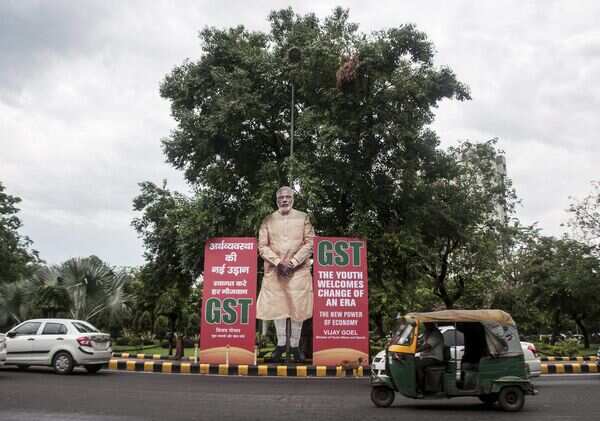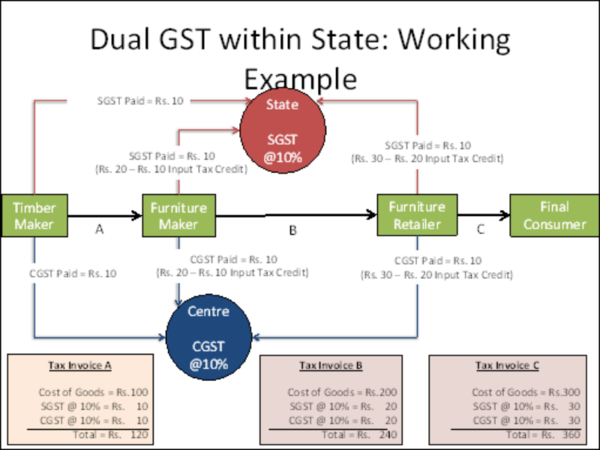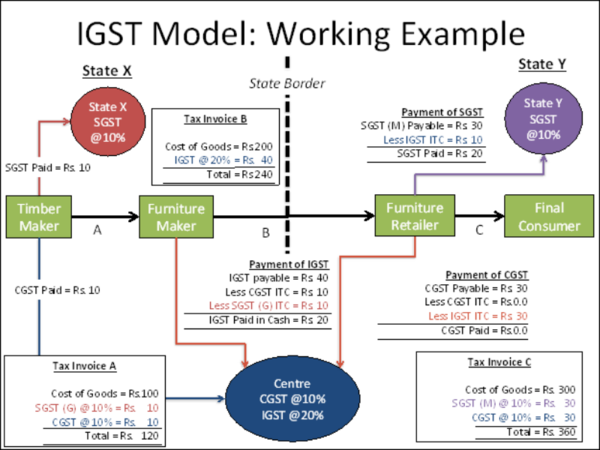- News
- Business News
- India Business News
- What is GST?
Trending
This story is from June 29, 2017
What is GST?
GST will be levied on value additions at each stage of the production cycle – buying raw materials, processing, manufacturing, warehousing and sale to customers - the monetary worth added at each stage to achieve the final sale to the end customer will be taxed.

In what makes it significantly different from the existing system, GST is a destination-based tax
Key Highlights
- GST is a multi-stage, destination-based tax that will be levied on every value addition
- Final consumer will bear only the GST charged by the last dealer in the supply chain
- Many VATs and levies currently in vogue will be subsumed by the new system come July 1
GST or Goods and Services Tax , set to launch on July 1, is a multi-stage, destination-based tax that will be levied on every value addition.
Read about the launch details here
Set to revolutionise the way India does its taxes, GST will be levied on value additions at each stage of the production cycle – buying raw materials, processing, manufacturing, warehousing and sale to customers - the monetary worth added at each stage to achieve the final sale to the end customer will be taxed.The final consumer will thus bear only the GST charged by the last dealer in the supply chain, with set-off benefits at all the previous stages.
 Commuters drive past a huge cutout of Prime Minister Narendra Modi, next to Goods and Services Tax (GST) banners in New Delhi. (PTI photo)
Commuters drive past a huge cutout of Prime Minister Narendra Modi, next to Goods and Services Tax (GST) banners in New Delhi. (PTI photo)
In what makes it significantly different from the existing system, GST is a destination-based tax. Currently, the central government levies excise duty on the manufacture, and then the state adds VAT (Value Added tax) when the item is sold to the next stage in the cycle — i.e. from processed raw material like rubber to be manufactured into tyres. Then there would be a VAT at the next point of sale - i.e. when the tyre is sold to the dealership and then to the consumer and so on.
Read: How GST is billed to integrate India into a common market, bigger than the EU
If the tyres are made in Tamil Nadu and used in Delhi, under the GST regime, Delhi will earn the revenue on the final sale, because it is a destination-based tax and this revenue will be collected at the final point of sale/destination. Tamil Nadu will however get the benefits of GST levied at the earliest stages of manufacturing since the tyre was made there.
One Nation, One Tax? Not Quite, Not Yet
GST would apply to all goods other than crude petroleum, motor spirit, diesel, aviation turbine fuel and natural gas. It would apply to all services barring a few to be specified. With the increase of international trade in services, GST has become a global standard. GST will ensure that indirect tax rates and structures are common across India and increase the ease of doing business. This would make doing business in the country tax neutral, irrespective of the choice of place of doing business.
Your complete guide to GST rates is here
The government has opted for four slabs for both goods and services — 5%, 12%, 18% and 28%. In addition, several items face zero levy, while bullion will attract 3% GST and luxury and sin goods that are in the top bracket will also attract a cess that will be used to compensate states for revenue loss.
The proposed tax system will take the form of “dual GST” which is concurrently levied by central and state government. This will comprise of:
• Central GST (CGST) which will be levied by Centre
• State GST (SGST) Which will be levied by State
• Integrated GST (IGST) – which will be levied by Central Government on inter-State supply of goods and services.
Revenue secretary Hasmukh Adhia has said that the ultimate goal of the government should be to move to a single- or dual-rate goods and services tax regime.
Read here what Hasmukh Adhia said
"Ideally like all other advanced countries, we should have got one GST which is levied by one government only, and not a dual GST and also a GST in which there is a uniform rate. In our country, where there are different stratas of society to be looked after, it's not possible to have an ideal GST. We are in a good direction. We will prefer to have a single GST rate but after sometime. That should be the ultimate goal — instead of having too many complicated rates, at least one or two rates should be there," Adhia said
But pending that here’s a graphic example of how the system as implemented from July 1 will work:

Many VATs and levies currently in vogue will be subsumed by the new system come July 1.
At the Central level, the following taxes are being subsumed:
1. Central Excise Duty,
2. Additional Excise Duty,
3. Service Tax,
4. Additional Customs Duty commonly known as Countervailing Duty, and
5. Special Additional Duty of Customs.
At the State level, the following taxes are being subsumed:
1. Subsuming of State Value Added Tax/Sales Tax,
2. Entertainment Tax (other than the tax levied by the local bodies), Central Sales Tax (levied by the Centre and collected by the States),
3. Octroi and Entry tax,
4. Purchase Tax,
5. Luxury tax, and
6. Taxes on lottery, betting and gambling.
Quick Links:
Modi Speach on GST
Know all the key GST India launch highlights
GST Impact on Cars & Bikes
Read this story in Tamil
Read about the launch details here
Set to revolutionise the way India does its taxes, GST will be levied on value additions at each stage of the production cycle – buying raw materials, processing, manufacturing, warehousing and sale to customers - the monetary worth added at each stage to achieve the final sale to the end customer will be taxed.The final consumer will thus bear only the GST charged by the last dealer in the supply chain, with set-off benefits at all the previous stages.

Read here what will become cheaper and dearer under GST
In what makes it significantly different from the existing system, GST is a destination-based tax. Currently, the central government levies excise duty on the manufacture, and then the state adds VAT (Value Added tax) when the item is sold to the next stage in the cycle — i.e. from processed raw material like rubber to be manufactured into tyres. Then there would be a VAT at the next point of sale - i.e. when the tyre is sold to the dealership and then to the consumer and so on.
Read: How GST is billed to integrate India into a common market, bigger than the EU
If the tyres are made in Tamil Nadu and used in Delhi, under the GST regime, Delhi will earn the revenue on the final sale, because it is a destination-based tax and this revenue will be collected at the final point of sale/destination. Tamil Nadu will however get the benefits of GST levied at the earliest stages of manufacturing since the tyre was made there.
One Nation, One Tax? Not Quite, Not Yet
GST would apply to all goods other than crude petroleum, motor spirit, diesel, aviation turbine fuel and natural gas. It would apply to all services barring a few to be specified. With the increase of international trade in services, GST has become a global standard. GST will ensure that indirect tax rates and structures are common across India and increase the ease of doing business. This would make doing business in the country tax neutral, irrespective of the choice of place of doing business.
Your complete guide to GST rates is here
The government has opted for four slabs for both goods and services — 5%, 12%, 18% and 28%. In addition, several items face zero levy, while bullion will attract 3% GST and luxury and sin goods that are in the top bracket will also attract a cess that will be used to compensate states for revenue loss.
What is GST?
The proposed tax system will take the form of “dual GST” which is concurrently levied by central and state government. This will comprise of:
• Central GST (CGST) which will be levied by Centre
• State GST (SGST) Which will be levied by State
• Integrated GST (IGST) – which will be levied by Central Government on inter-State supply of goods and services.
Revenue secretary Hasmukh Adhia has said that the ultimate goal of the government should be to move to a single- or dual-rate goods and services tax regime.
Read here what Hasmukh Adhia said
"Ideally like all other advanced countries, we should have got one GST which is levied by one government only, and not a dual GST and also a GST in which there is a uniform rate. In our country, where there are different stratas of society to be looked after, it's not possible to have an ideal GST. We are in a good direction. We will prefer to have a single GST rate but after sometime. That should be the ultimate goal — instead of having too many complicated rates, at least one or two rates should be there," Adhia said
But pending that here’s a graphic example of how the system as implemented from July 1 will work:


Many VATs and levies currently in vogue will be subsumed by the new system come July 1.
At the Central level, the following taxes are being subsumed:
1. Central Excise Duty,
2. Additional Excise Duty,
3. Service Tax,
4. Additional Customs Duty commonly known as Countervailing Duty, and
5. Special Additional Duty of Customs.
At the State level, the following taxes are being subsumed:
1. Subsuming of State Value Added Tax/Sales Tax,
2. Entertainment Tax (other than the tax levied by the local bodies), Central Sales Tax (levied by the Centre and collected by the States),
3. Octroi and Entry tax,
4. Purchase Tax,
5. Luxury tax, and
6. Taxes on lottery, betting and gambling.
Quick Links:
Modi Speach on GST
Know all the key GST India launch highlights
GST Impact on Cars & Bikes
Read this story in Tamil
End of Article
FOLLOW US ON SOCIAL MEDIA















